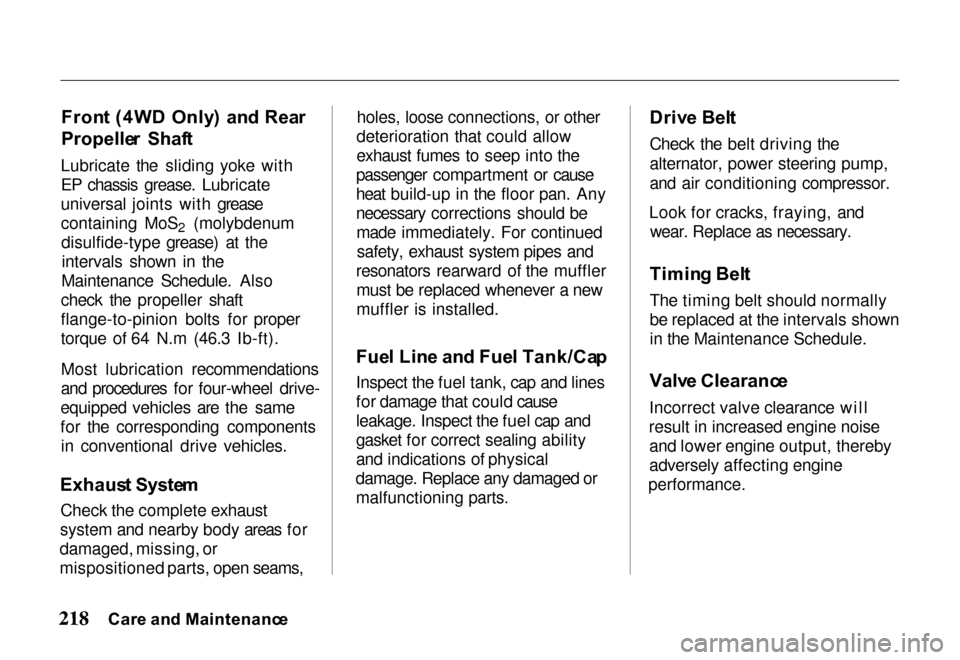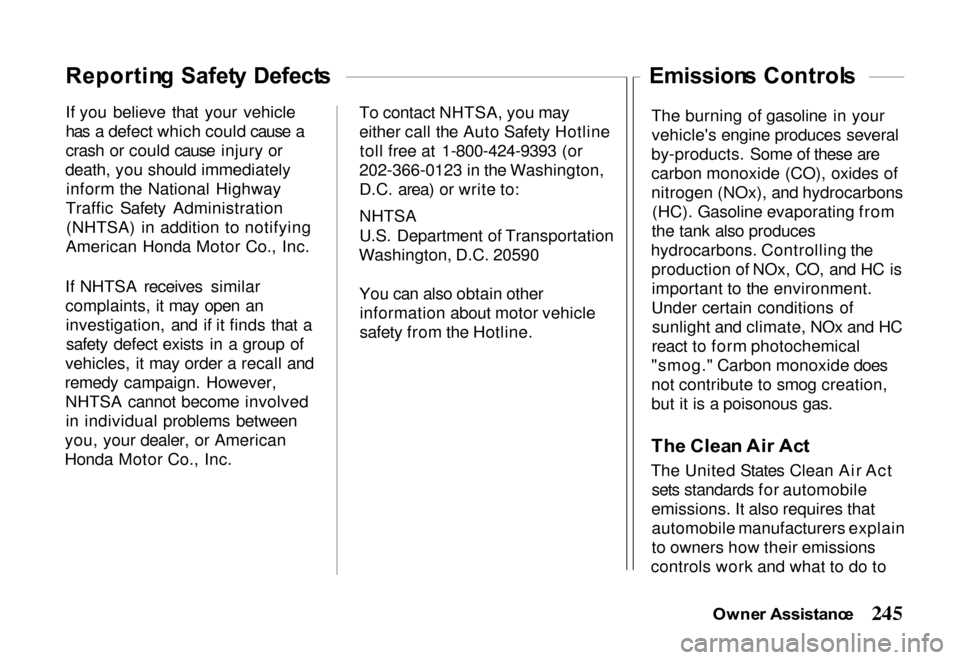open gas tank HONDA PASSPORT 2000 2.G Owners Manual
[x] Cancel search | Manufacturer: HONDA, Model Year: 2000, Model line: PASSPORT, Model: HONDA PASSPORT 2000 2.GPages: 267, PDF Size: 3.03 MB
Page 221 of 267

Fron
t (4W D Only ) an d Rea r
Propelle r Shaf t
Lubricate the sliding yoke with
EP chassis grease. Lubricate
universal joints with grease
containing MoS 2 (molybdenum
disulfide-type grease) at the intervals shown in the
Maintenance Schedule. Also
check the propeller shaft
flange-to-pinion bolts for proper
torque of 64 N.m (46.3 Ib-ft).
Most lubrication recommendations
and procedures for four-wheel drive-
equipped vehicles are the same
for the corresponding components in conventional drive vehicles.
Exhaus t Syste m
Check the complete exhaust
system and nearby body areas for
damaged, missing, or
mispositioned parts, open seams, holes, loose connections, or other
deterioration that could allow
exhaust fumes to seep into the
passenger compartment or cause
heat build-up in the floor pan. Any
necessary corrections should be made immediately. For continuedsafety, exhaust system pipes and
resonators rearward of the muffler must be replaced whenever a new
muffler is installed.
Fue l Lin e an d Fue l Tank/Ca p
Inspect the fuel tank, cap and lines
for damage that could cause
leakage. Inspect the fuel cap and
gasket for correct sealing ability
and indications of physical
damage. Replace any damaged or
malfunctioning parts.
Driv
e Bel t
Check the belt driving the
alternator, power steering pump,
and air conditioning compressor.
Look for cracks, fraying, and wear. Replace as necessary.
Timin g Bel t
The timing belt should normally
be replaced at the intervals shown
in the Maintenance Schedule.
Valv e Clearanc e
Incorrect valve clearance will
result in increased engine noise and lower engine output, thereby
adversely affecting engine
performance.
Car e an d Maintenanc e
Page 248 of 267

If you believe that your vehicle
has a defect which could cause a
crash or could cause injury or
death, you should immediately inform the National Highway
Traffic Safety Administration (NHTSA) in addition to notifying
American Honda Motor Co., Inc.
If NHTSA receives similar
complaints, it may open an investigation, and if it finds that asafety defect exists in a group of
vehicles, it may order a recall and
remedy campaign. However, NHTSA cannot become involvedin individual problems between
you, your dealer, or American
Honda Motor Co., Inc. To contact NHTSA, you may
either call the Auto Safety Hotline
toll free at 1-800-424-9393 (or
202-366-0123 in the Washington,
D.C. area) or write to:
NHTSA
U.S. Department of Transportation
Washington, D.C. 20590
You can also obtain otherinformation about motor vehicle
safety from the Hotline.
Emission
s Control s
The burning of gasoline in your vehicle's engine produces several
by-products. Some of these are
carbon monoxide (CO), oxides of
nitrogen (NOx), and hydrocarbons (HC). Gasoline evaporating from
the tank also produces
hydrocarbons. Controlling the production of NOx, CO, and HC isimportant to the environment.
Under certain conditions of sunlight and climate, NOx and HC
react to form photochemical
"smog." Carbon monoxide does
not contribute to smog creation,
but it is a poisonous gas.
Th e Clea n Ai r Ac t
The United States Clean Air Act sets standards for automobile
emissions. It also requires that automobile manufacturers explain
to owners how their emissions
controls work and what to do to
Owner Assistanc e
Reportin
g Safet y Defect s